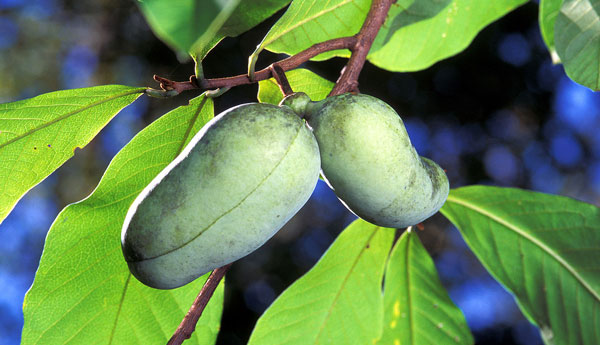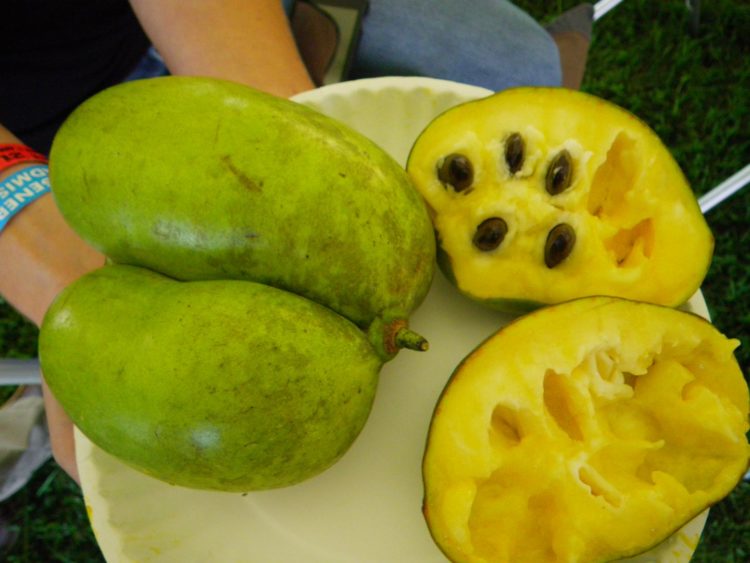
Love tropical fruits, but live pretty far outside the tropical zone? Keep an eye out for the good old “Appalachian Banana.” Indigenous to the temperate regions of North America, the pawpaw gained a quite foothold thanks to colonial fans of the fruits. Two such men were George Washington and Thomas Jefferson, who cultivated pawpaws throughout Virginia; there, you can still find the fruit on the edge of forests. Indeed, even Lewis and Clark sometimes subsisted on pawpaws during their transcontinental trek westward. Today, the fruits range across the subtropic and temperate zones of North America (like Virginia). Read on for some fun facts about this fantastic fruit.
Identification
To start, contrary to even what you’ve read so far in this article, pawpaws are not *actually* a fruit, though folks usually reference them as such. Technically, pawpaws are simply a massive berry. The pawpaw tree itself usually ranges from six to 12 yards high, and can start bearing fruit at anywhere from four to eight years. Leaves are oblong, usually 6 to 12 inches long and 1.5 to 4 inches wide. The oval-shaped pawpaws themselves start green, and slowly ripen to an orange-yellow. Inside, they have a custard-like consistency, surrounding a center full of large, spicy black seeds.
Consumption
While you can eat a green pawpaw, you had best cook it first. Green pawpaws are dangerously high in latex, and should not be eaten raw. Cooked however, they are just fine, though personally I dislike the taste. Of course, if you have a little patience, the ripe fruit can be consumed right off the tree. While you can eat straight through the skin, it will make the fruit a tad more bitter. In my opinion, it’s best to peel the pawpaw before consuming the delicious interior. Speaking of which, the flavor is similar to a banana, combined with more citrusy tropical fruit like mango, or pineapple.
Nutrition
As far as nutrition goes, pawpaws are high in quite a few things. As is true for most citrus plants, pawpaws are very high in vitamin C, but they’ve got a few other goodies up their sleeves as well. The fruit is also full of magnesium, iron, copper, and manganese. They’re similarly a good source of potassium, several essential amino acids, riboflavin, niacin, calcium, phosphorus, and zinc. That’s quite a lot for a little fruit, and puts it roughly on par with bananas, apples and oranges for nutrition.
Sound like a flavorful fruit you may be interested in? Take a look around on your next hike. If you’re in the subtropics (think, on latitude with the Florida panhandle) many pawpaws are already ripe, and typically have been since mid-August. If you’re a further north, chances are you have another week or so, as they won’t ripen until late September or early October. Once you pick it, make sure you eat it quick! One reason you don’t tend to see pawpaws for sale commercially, is they don’t keep well. Generally if you wait more than a few days, the fruit will spoil. Good luck out there, happy foraging and don’t forget, with pawpaws, tempus fugit.
A humble homesteader based in an undisclosed location, Lars Drecker splits his time between tending his little slice of self-sustaining heaven, and bothering his neighbors to do his work for him. This is mainly the fault of a debilitating predilection for fishing, hunting, camping and all other things outdoors. When not engaged in any of the above activities, you can normally find him broken down on the side of the road, in some piece of junk he just “fixed-up.”

Lars Drecker says
Hey yall, Lars here again. It’s been a rough couple weeks for corrections, and I’d like to thank yall for finding yet another error of mine (this one more than a typo). While I’ve been growing and eating pawpaws for most of my life, It turns out I was given some false information about the history of their cultivation, and their relationship to the similarly-named, tropical papaya. With a little research and while eating a nice helping of humble pie, the article has been updated with the correct information. Thanks for keeping me honest on here!
Herrick Teeter Jr. says
Paw Paws are not tropical, They can be grow outside in upstate NY, deal with our winters with temps down to about -29F for a short time with snow cover. They are also commonly called the Michigan Bananna. They have a unique custad taste and texture but bruise so easily when picked that they will not ship well and are best eaten fresh off the tree.
Lars Drecker says
Hey Herrick, thanks for catching this error. While I’ve been growing and eating pawpaws for most of my life, It turns out I was given some false information about the history of their cultivation, and their relationship to the similarly-named, tropical papaya. With a little research and while eating a nice helping of humble pie, the article has been updated with the correct information. Thanks for keeping me honest on here!
tom says
The picture at the top of the article is a papaya, the rest of the article is about the pawpaw
Lars Drecker says
Hey Tom, thanks for catching this error. While I’ve been growing and eating pawpaws for most of my life, It turns out I was given some false information about their relationship to the similarly-named, tropical papaya. Was under the impression they were close cousins, and couldn’t find a suitable picture of a pawpaw in time for my deadline. The article has been updated with the correct information and photo. Thanks for keeping me honest on here!
Just Me says
Attachment
Your article is about PAPAYA, not Paw-Paws.
James says
You need to learn the difference. Paw-Paws are an entirely different thing from what the article described.
Lars Drecker says
Hey Just Me; this article is about pawpaws, which I’ve grown and eaten for most’ve my life, but I did have some wrong information on the history of their cultivation, and their relationship to the similarly-named, tropical papaya. Was under the impression they were extremely close cousins, which could not be further from the truth, as it turns out. With a little research and while eating a nice helping of humble pie, the article has been updated with the correct information. Appreciate you keeping me honest on here!